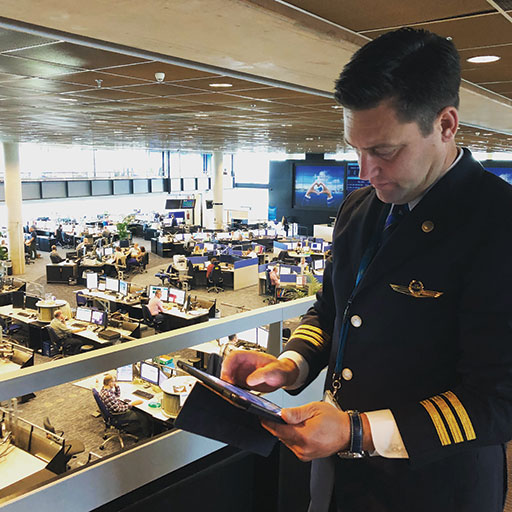In a visit to the KLM Operations Control Center, Aviation Maintenance Magazine editor-in-chief Joy Finnegan spoke with Boeing and KLM to learn about the RouteSync process and how it is working for the airline.
Boeing has introduced a new tool called RouteSync that eliminates manual pre-flight processes for airlines by automating flight planning and performance data entry with the airplane’s Flight Management System (FMS) computer. RouteSync is now helping streamline the pre-flight process by saving airlines valuable time before takeoff. With the push of a few buttons, the service allows pilots to instantly upload the flight plan and performance data. By eliminating the task of manually typing in the information, pilots save between three to five minutes on domestic flights and up to 15 minutes for international travel.
Pilots can now simply enter the departure, destination and flight number in to the FMS. Then by hitting the request button, the flight plan is automatically loaded into the computer versus having to manually enter the flight plan. On long haul flights this can save time during one of the busiest and most stressful periods in the preflight departure process. Eliminating the manual entry also reduces the possibility of human error while entering long, complicated routings.

During trials, Boeing estimated that using RouteSync eliminated between three to 15 minutes of pre-flight operational time spent entering data. This allows pilots to focus on other mission critical tasks. Boeing worked with airline partner KLM during the development.
During the test period, KLM says it saved between 200-335 hours during a six-week flight trial period, through automated data entry by to uplinking 4,021 flight plans. Boeing touts that “RouteSync promotes on-time departures through automation” and is a strong new addition to their digital product portfolio.
“RouteSync saves me somewhere between five and ten minutes on average,” says Robert Schuringa, first officer and instructor/examiner on the B777 for KLM Royal Dutch Airlines. “It gives me more time and helps speed up the process to ensure an on-time departure.”
“We are now able to turn an aircraft a lot faster,” says Jim Hamilton, RouteSync project manager at Boeing. “The old school way was to print out the route from dispatch, if there was a change in the flight plan. When there was a change, you had to send it out to the ground station and they would print it out and carry it out to the pilot. Then the pilot enters all the information in. So, with this, we are automating this process. We are looking at how do we make the disruption recovery go faster,” he says, in the case of last minute changes due to weather reroutes or other operationally needed changes. “In the past, we were heavily relying on voice and paper communications. Enroute, the challenge we are facing is ever more congestion in the airspace, weather, and other operational factors. So how do you exchange an updated flight plan or the final performance data between the operations center, where optimization can be carried out, and get that info out to the pilot who has to make the final decision [about the route, fuel load, etc.]?”

Schuringa says in the old process, prior to the flight, the preparations for each flight were conducted where things like optimum routing, weather, Notams, the technical status of the aircraft and other factors are considered, and then sent to the crew center. “There, we had printers printing the flight plan with all the airways and waypoints and we had to physically type it in during the preflight onboard the aircraft. The new procedure is, we have all this information on the iPad and we can check if we agree with the routing and final fuel based on those factors I mentioned.” Then the crew can accept the route and performance data on the iPad and it is stored on the server at the KLM Operations Control Center. “Later, we can access it from the airplane via ACARS. So now, when we arrive at the aircraft, we don’t have to put in all the airways and performance data anymore,” Schuringa says. “The whole route can be accessed directly from the server. We simply put in the flight number and the city pair, like AMS-JFK, and the ACARS sends the request to the server. It will then send back the complete routing and upload it directly into the FMS.” At this point it can be dual verified by the crew prior to executing it. “Thereby you save approximately five to ten minutes of programming and that time can be used for other preflight preparations,” he adds. Additionally, Schuringa says, when flying parallel tracks over the ocean crews used to have to manually put in all the waypoints using lat/long positions and a typing error could occur. RouteSync eliminates those possible errors.
Hamilton says another benefit is that the system can help detect any synchronization issues between databases. The service will upload the flight route, weather conditions and other performance data into the FMS. RouteSync includes new features like route validation. It will also insert or remove discontinuities in the flight plan. If there’s an error, the service won’t upload the information and will send an advisory to the pilot and the airline, Hamilton says. The service is available for Boeing planes and other commercial aircraft. KLM has been using the service for a year. “It worked perfectly, from day one,” Schuringa says.
